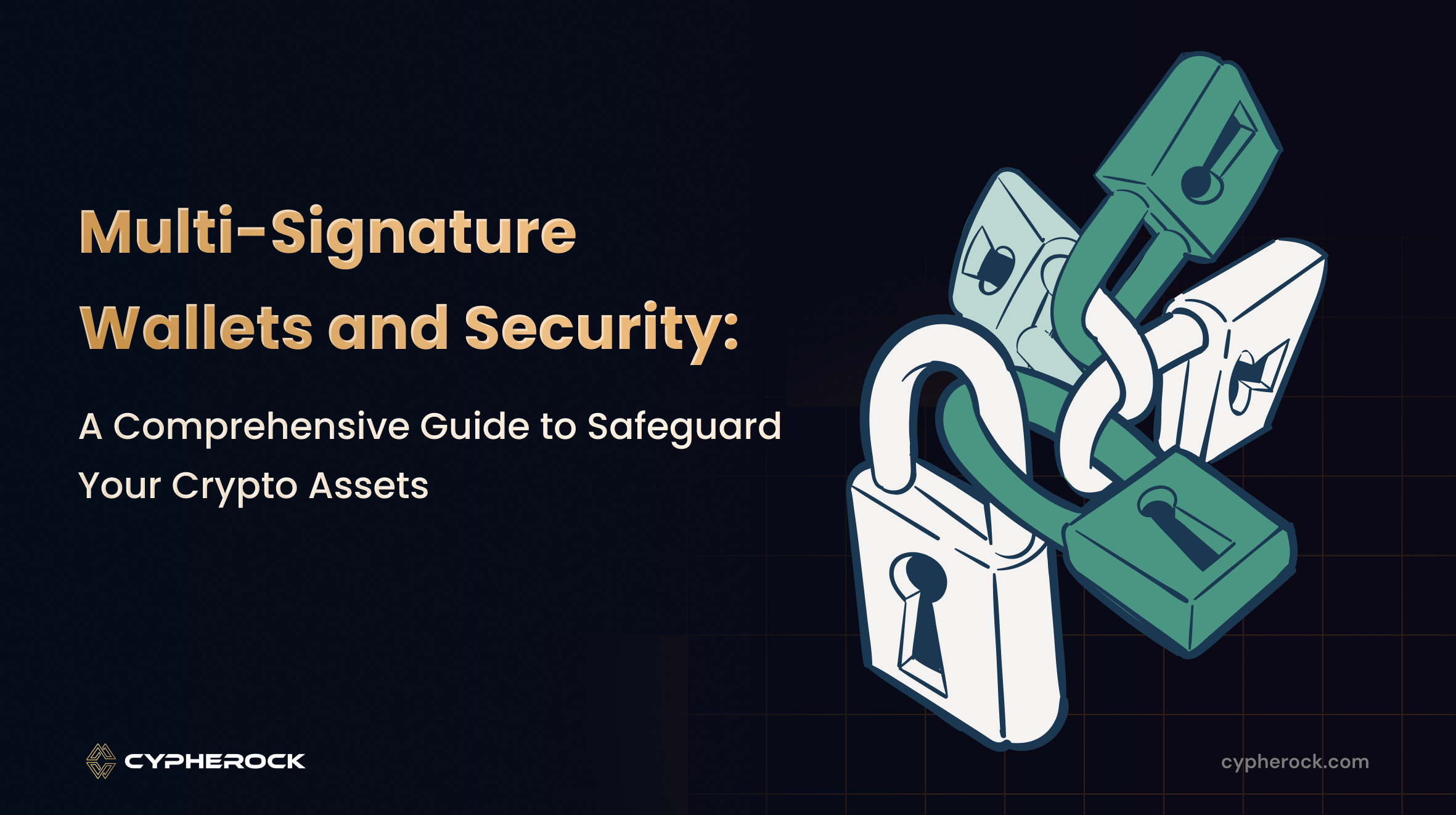

As digital assets like Bitcoin and Ethereum grow in popularity, keeping them safe has become more important than ever. Crypto wallets are essential, but not all wallets are equally secure. Multi-signature wallets are a powerful solution designed to add an extra layer of security to your crypto assets.
By learning about multi-signature wallets, you'll discover how they work and why they are a trusted choice. They don’t rely on just one person or one device for access, making them far safer than traditional wallets. Understanding this concept will help you make smarter choices when it comes to securing your investments.
In this article, we’ll explore what multi-signature wallets are, how they work, their key features, and their types. We’ll also discuss their limitations and how technologies like Shamir Secret Sharing can address those issues.
By the end, you’ll have a clear understanding of whether multi-signature wallets are right for you and how to safeguard your crypto effectively.
A multi-signature wallet, often called a "multi-sig" wallet, is a type of cryptocurrency wallet that requires multiple approvals to complete a transaction. Instead of relying on just one private key to access funds, multi-signature wallets use two or more keys.
Think of it like a digital lockbox. To open it, you need multiple keys instead of just one. For example, if a wallet has three keys, you might need at least two of them to approve a transaction. This makes it much harder for hackers or mistakes to cause a loss of funds.
Multi-signature wallets are designed to add an extra layer of security. They are especially useful for people who want to protect their crypto from theft, share control among multiple people, or prevent unauthorized transactions. Whether you are a solo investor or part of a group, multi-signature wallets help you keep your digital assets safe.
A multi-signature wallet works by requiring multiple private keys to approve a transaction. Instead of just one person having control, the wallet splits control among two or more parties. This setup adds extra security and flexibility to manage your funds.
Here’s how it works step by step:
This setup ensures that no single keyholder has full control. Even if one key is lost or compromised, your funds are still safe because additional keys are needed. Multi-signature wallets are especially useful for businesses, families, or anyone who values strong protection for their crypto assets.
Multi-signature wallets offer several features that make them a reliable option for securing your cryptocurrency. These wallets go beyond basic security and provide added functionality to meet different needs. Let’s explore their key features:
Multi-signature wallets come in various forms, tailored to meet different user needs. The key differences lie in how they are implemented and used. Here are the main types of multi-signature wallets:
What They Are: Wallets that use physical devices like Cypherock, Ledger, Trezor, or similar hardware wallets to store private keys securely. Cypherock, while not a traditional multi-signature wallet, uses an innovative multi-share system to enhance security.
How They Work: Each device holds a key, and multiple devices or approvals are required to authorize transactions.
Best For: Users who prioritize offline storage and maximum security for critical assets.
What They Are: Applications that run on desktop or mobile devices to manage keys.
How They Work: Keys are distributed across different devices or accounts, with transaction approvals handled through the app.
Best For: Users seeking flexibility and ease of use without relying on physical hardware.
What They Are: Services where a third party, like an exchange or wallet provider, manages some or all of the keys on behalf of the user.
How They Work: Control is shared between the user and the custodian, requiring multiple approvals for transactions.
Best For: Businesses or users who prefer professional management and trust the custodian for key security.
What They Are: Wallets where the user has full control over all the keys, without involving a third party.
How They Work: The wallet software allows users to independently manage and distribute keys.
Best For: Users who prioritize self-custody and complete control over their funds.
What They Are: Wallets that combine custodial and non-custodial features to balance flexibility and security.
How They Work: Users keep some keys, while a trusted service manages others for backup or recovery purposes.
Best For: Users who want a blend of self-custody with professional assistance for added security.
What They Are: Wallets that use smart contracts on blockchains like Ethereum to enforce multi-signature transaction approvals.
How They Work: The smart contract automates and enforces approval rules, ensuring transparency and tamper-proof execution.
Best For: Advanced users involved in DeFi, decentralized autonomous organizations (DAOs), or projects requiring programmable governance.
While multi-signature wallets offer strong security and flexibility, they also come with certain limitations. Understanding these drawbacks can help you decide if a multi-signature wallet is the right solution for your needs.
Setting up a multi-signature wallet can be confusing for beginners. It requires configuring multiple keys and devices.
Users with limited technical knowledge may struggle to implement or manage the wallet effectively.
Accessing funds can be slower since multiple approvals are required for every transaction. This may cause delays in situations requiring quick access to crypto, like during market fluctuations.
If too many keys are lost, you may permanently lose access to your funds. For example, in a "2-of-3" wallet, losing two keys means the wallet becomes inaccessible.
Not all cryptocurrencies and wallet providers support multi-signature functionality. This limits the ability to use multi-signature wallets for managing certain tokens or participating in specific blockchain ecosystems.
In shared wallets, delays or disagreements among keyholders can slow down decision-making. This makes multi-signature wallets less suitable for situations requiring instant or unilateral decisions.
While multi-signature wallets are highly secure, these limitations highlight the need to carefully evaluate your requirements. For those seeking alternative solutions, technologies like Shamir Secret Sharing may address some of these drawbacks.
Shamir Secret Sharing (SSS) offers an innovative way to address some of the limitations of multi-signature wallets. Named after Adi Shamir, one of the inventors of RSA encryption, this cryptographic method divides a private key into multiple "shares." Only a predefined number of shares are required to reconstruct the key, making it both secure and practical.
Shamir Secret Sharing (SSS) is a cryptographic method designed to split a private key into multiple "shares," allowing only a predefined number of shares to reconstruct the key. Developed by Adi Shamir, one of the creators of RSA encryption, this system ensures secure and practical key management. For example, a setup might require 2 out of 5 shares to recover the key.
The private key is divided into several shares using mathematical algorithms. Users can determine the total number of shares created and how many are required for recovery. These shares can be distributed to trusted individuals or stored securely in different locations. This eliminates the reliance on a single private key, drastically reducing risks of loss or theft.
Compared to multi-signature wallets, SSS offers several advantages:
SSS finds application in various scenarios:
Shamir Secret Sharing simplifies the complexity of multi-signature wallets, removing dependencies on multiple parties while maintaining high security. Its combination of advanced cryptography and practical usability offers a robust and accessible solution for cryptocurrency storage, paving the way for a more secure and user-friendly crypto ecosystem.
Protecting your cryptocurrency is more important than ever, and choosing the right solution can make all the difference. Multi-signature wallets are a trusted tool for adding layers of security by requiring multiple approvals for transactions. They are ideal for individuals, families, and businesses who want to reduce risks like hacking or unauthorized access.
However, multi-signature wallets also come with their own set of challenges, such as setup complexity, cost, and dependency on others. This is where Shamir Secret Sharing stands out as an innovative alternative. By splitting private keys into multiple shares, it offers strong security without the complications of traditional multi-signature wallets. With Shamir Secret Sharing, you gain better privacy, easier recovery, and flexibility to manage your crypto securely.
Both multi-signature wallets and Shamir Secret Sharing have unique strengths, and the best choice depends on your needs. Understanding these options empowers you to make smarter decisions about how to safeguard your assets. Whether you prioritize collaborative control or seamless security, these tools ensure your crypto stays protected in an ever-changing digital world.
Yes, it’s a good idea to have multiple wallets for different purposes. You can use one wallet for everyday transactions, another for long-term storage, and a third for specific types of assets like NFTs. This helps improve security by diversifying where your funds are stored.
Multisig (multi-signature) security requires more than one private key to authorize a transaction. Instead of just one person controlling access to a wallet, multiple authorized parties must sign off on any transaction, making it much harder for unauthorized users to steal assets.
You can tell if a wallet is multisig by checking its settings or looking at the wallet’s documentation. Multisig wallets typically display the number of signatures required to complete a transaction. Some popular multisig wallet services, like Gnosis Safe, also clearly indicate the number of signers in the wallet interface.
You should use a multisig wallet when you want to add an extra layer of security or involve multiple trusted parties in managing funds. This is especially useful for organizations, shared wallets, or when you want to safeguard assets by requiring multiple approvals before any transaction occurs.
Yes, hardware wallets like Cypherock are considered one of the safest ways to store crypto. Since they are offline, they are not vulnerable to online hacks. As long as you protect your hardware wallet and recovery keys, it’s nearly impossible for someone to steal your assets remotely.
